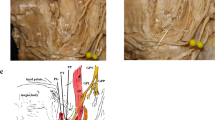Summary
Hemiglossal paralysis due to lesions of the peripheral hypoglossal nerve leads to marked muscle atrophy with disturbed functioning in a minority of cases. Reinnervation from the unparalyzed, contralateral side may then be desired. In animal experiments on cats, a Z-plasty of the midportion of the tongue was carried out by transposing a portion of the normal tongue musculature into the opposite side following denervation 1 month previously by resection of the hypoglossal nerve. Electromyography was performed 13 months later. The tongue was then examined histochemically in serial sections in search of the motor endplates together with the nerves fibers. However, there was no evidence for reinnervation in the specimens examined. Signs of successful “reanimation” of the tongue by Z-plasty may be caused by mechanical synkinesia due to scar formation rather than by actual reneurotization.
Similar content being viewed by others
References
Anonsen CK, Patterson HC, Trachy RE, Gordon AM, Cummings CW (1985) Reinnervation of skeletal muscle with a neuromuscular pedicle. Otolaryngol Head Neck Surg 93:48–57
Bennet G (1935) Die anatomische Grundlage der halbseitigen Zungenlähmung. Sitzungsber Ges Morphol Physiol Münch 44: 18–23
Bumm P (1974) Periphere Hypoglossusparesen. Laryngol Rhinol Otol 53:274–283
Cannon WB, Rosenblueth A (1949) The supersensitivity of denervated structures. Macmillan, New York
Crumley RL (1982) Experiments in laryngeal innervation. Laryngoscope [Suppl]92:30
Edström L, Kugelberg E (1969) Histochemical mapping of motor units in experimentally re-innervated muscle. Experientia 25:1044–1045
Erhardt W, Wrieth-Lobbe I, Schmeller M-L, Neumann G, Pfeiffer C, Pfeiffer U, Tolle W, Blümel G (1977) Anaesthesiologische Erfahrungen in der experimentellen Chirurgie. Anaesthesist 28:359–367
Miehlke A, Stennert E, Arold R, Chilla R, Penholz H, Kiihner A, Sturn V, Haubrich J (1981) Chirurgie der Nerven im HNO-Bereich. Arch Otolaryngol 231:89–449
Naumann C, Wigand ME, Duc BM (1973) Experimentelle Nervenimplantation in transplantierten Muskeln. Arch Klin Exp Ohren- Nasen- Kehlkopfheilkd 205:359–362
Pestronk A, Drachman DB (1978) A new stain for quantitative measurement of sprouting at neuromuscular junctions. Muscle Nerve 1:70–74
Rubin LR, Mishriki JJ, Speace G (1984) Reanimation of the hemiparalytic tongue. Plast Reconstr Surg 73: 184–194
Wigand ME, Naumann C, Hölldobler G (1969) Versuche zur Reinnervation des Abduktormuskels nach Rekurrenslähmung durch Einpflanzen freier Nervenimplantate zum Nervus phrenicus. Arch Klin Exp Ohren- Nasen- Kehlkopfheilkd 194: 372–376
Author information
Authors and Affiliations
Rights and permissions
About this article
Cite this article
Hosemann, W., Wigand, M.E., Herrlinger, P. et al. Surgical reneurotization of the tongue after unilateral paralysis of the hypoglossal nerve. Eur Arch Otorhinolaryngol 248, 95–98 (1990). https://doi.org/10.1007/BF00240228
Received:
Accepted:
Issue Date:
DOI: https://doi.org/10.1007/BF00240228




